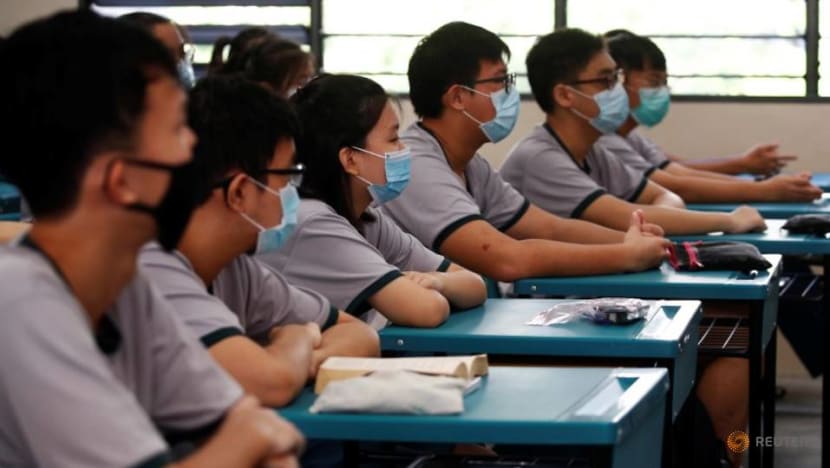commentary Commentary
Commentary: Home-based learning this time round will be less traumatic
It can feel like a repeat of 2020’s educational moment but things are very different the second time around, says Cherie Tseng.

A kid spends time on a computer (Photo: Reuters)
SINGAPORE: We cannot say we did not see the writing on the wall. All signs pointed to the eventuality that parents would need to accept home-based learning (HBL).
We have been bombarded with news of the relentlessness of the B1617, a double mutant COVID-19 variant sweeping across India, US, UK and Germany, leaving scores of victims in its wake. Its arrival to our sunny shores is an eventuality.
By May 3, the Ministry of Health (MOH) would find 29 COVID-19 local cases infected with variants of concern or interest. The multi-ministry task force would later announce that these new strains have higher attack rates, are more infectious, and are causing larger clusters than before.
And on Sunday (May 16), Singapore was back in Phase 2 (Heightened Alert). Yet unlike the circuit breaker of the previous year when all activities save essential ones were prohibited, this round of public health safety measures offered some wiggle room on heading out but with stricter limits.
READ: Commentary: Our juggling act with home-based learning last year was mental
READ: Commentary: Five pandemic lessons we have learnt that should tide us over any surge in cases
FROM PIVOTING TO PREPAREDNESS
If my social media feed was a barometer, people did not seem as devastated or caught by surprise as much as they seemed to have a weary sense of “here we go again” and a deep resentment against the virus. There is a sense of ennui, but also a clear-eyed understanding on how this whole shebang works.
Schools have prepped students on the possibility of reverting to HBL. Teachers have gone through the drill.
My children tell me they have been told that COVID-19 remains a real and present danger and so behaviours at school have been adjusted with new rules even before Sunday’s announcement: No more pack-and-play recess, canteens had designated and classrooms had exam-styled seating. Masks and the washing of hands have long been features of their new normal.

If last year’s word was “pivot” — from our usual in-person way of functioning to a hybridised one where the option of virtual meetings for school and work is de rigueur — this year’s word has to be “prepared”.
We cannot deny it feels like we are starring in our very own Groundhog Day movie, except we are further along, having already figured some stuff out.
As working adults, we have stepped back somewhat seamlessly into split teams and now into work-from-home mode, eased by arrangements like access to the collective work cloud already being in place.
We have gone back to transacting online and planning meals, knowing we cannot dine out anymore. Businesses are back to posting online order deals. Even the uncle who makes my favourite noodles reminded me I can order via the Grab app.
READ: Commentary: SPACs are all the rage now but few aware of hidden dangers
WHY IT IS DIFFERENT THIS TIME
While we were caught with our proverbial pants down when the pandemic first reared its ugly head early in 2020; this time, we seem less timorous and more sure-footed even if this new wave of infections cuts closer to home for most parents.
Speculation had been rife for days on parenting chats that this strain seems to impact the young ones more. This was a point confirmed by the new Minister of Education Chan Chun Sing at Sunday’s press briefing when he said that the new mutations of the coronavirus are “much more virulent” and “seem to attack the younger children”.
So compared to the last time we had to close schools, this time, the stakes are much higher with more children affected and the spread occurring despite masks, vaccination and a host of existing safety measures.

A family friend sent a text to inform us that their nine-year-old son has been issued a Quarantine Order (QO). Gratefully, all is stable and good so far.
This is why, when it was announced that all primary and secondary schools, as well as junior colleges and Millennia Institute, will shift to full HBL from Wednesday (May 19) until the end of the term on May 28 – it did not come as a shock.
Parents were not only receptive but incredibly relieved in some cases, on the back of fears their children could be infected.
I am a lucky parent – there is space and extra pair of hands to help me with my children, with two in primary school and another in kindergarten. I am already working from home so I intend to keep all three home.
READ: Commentary: Am I a bad mum for leaving my kid in childcare while returning to work?
READ: Commentary: The joys and frustrations of home-based learning
We have worked it out – who sits where, what to do, and how to give each other space when the other is working. It is not just respecting the need for quiet when mummy or daddy has a virtual meeting, but vice versa when the kids have their activities online.
We are also entering a shorter season of HBL with mid-year assessments already concluded and only less than two weeks left to this school term. So, mentally, the ask seems more manageable.

School CCAs and sports classes have also mostly sidestepped with an online programme — not ideal but not bad given the circumstances.
Our children are also getting into action to make these work. Last night, after the news broke, one of my sons went down to clean the base of his track shoes so he could use it indoors.
READ: Commentary: Your PE teacher’s secret headaches during a year of COVID-19
Enrichment classes have adopted an ongoing hybrid mode already in place having all invested in infrastructure to ensure business-as-usual regardless.
No parent likes the prospect of home-bound kids all through the school holidays, but it’s a small price to pay to prevent escalation.
For many other parents who don’t have these options, we can’t thank the teachers in school and childcare centres enough – for helping front-liners do their work by taking care of their children.
Listen to two parents share their front-row experience to their kids' educational journey of home-based learning during the circuit breaker on CNA's Heart of the Matter podcast:
THE COMMON FIGHT
With all the recent talk about the relevance of PSLE scores and the weighted assessment season that have just passed in schools, it is a small leap for us to draw the parallel that we are all sitting for a massive, prolonged, collective exam.
It is a life-altering, generation-defining one where the rules are murky, the goal posts keep changing and, unfortunately, the points do matter.
But unlike taking the surprise examination of 2020, this time, we have revised intensely, done the prescribed stack of past-year papers, and attended all the remedial lessons. Not the chop-plus-guarantee we hoped for, but it’s not too unfamiliar.
Dr Mariam Aljunied, adjunct Associate Professor at the National University of Singapore’s Psychology department reminds us, fittingly on a podcast titled The Future, to view emerging COVID-19 landing points as the “next normal”, rather than a new one.
The latter divides the world into a pre and post coronavirus one when it’s hardly the case. This former acknowledges how the present is simply the next in the line of new normals — and this too shall pass.
READ: Commentary: The struggle mums in their 30s, 40s face juggling young kids and work is real
READ: Commentary: Booster shot for COVID-19 - not everyone needs it
I will not downplay the disquiet and fatigue that this long COVID-19 period brings, with its twists and turns. But we are definitely better equipped.
As much as we are in a state of heightened alertness, we are also in a heightened state of preparedness and readiness. We have been able to make the transition to tightened measures more smoothly and expediently.
We have practised for this — at home, work and school. This is not our first rodeo. We know there are enough toilet rolls to go round. We know this is a marathon, not a sprint. We whine but we also appreciate that we have much to be grateful for.
BOOKMARK THIS: Our comprehensive coverage of the COVID-19 pandemic and its developments
Download our app or subscribe to our Telegram channel for the latest updates on the coronavirus outbreak: https://cna.asia/telegram
Cherie Tseng is Chief Operations Officer at a local fintech company, a mother of three and editor with The Birthday Collective.














